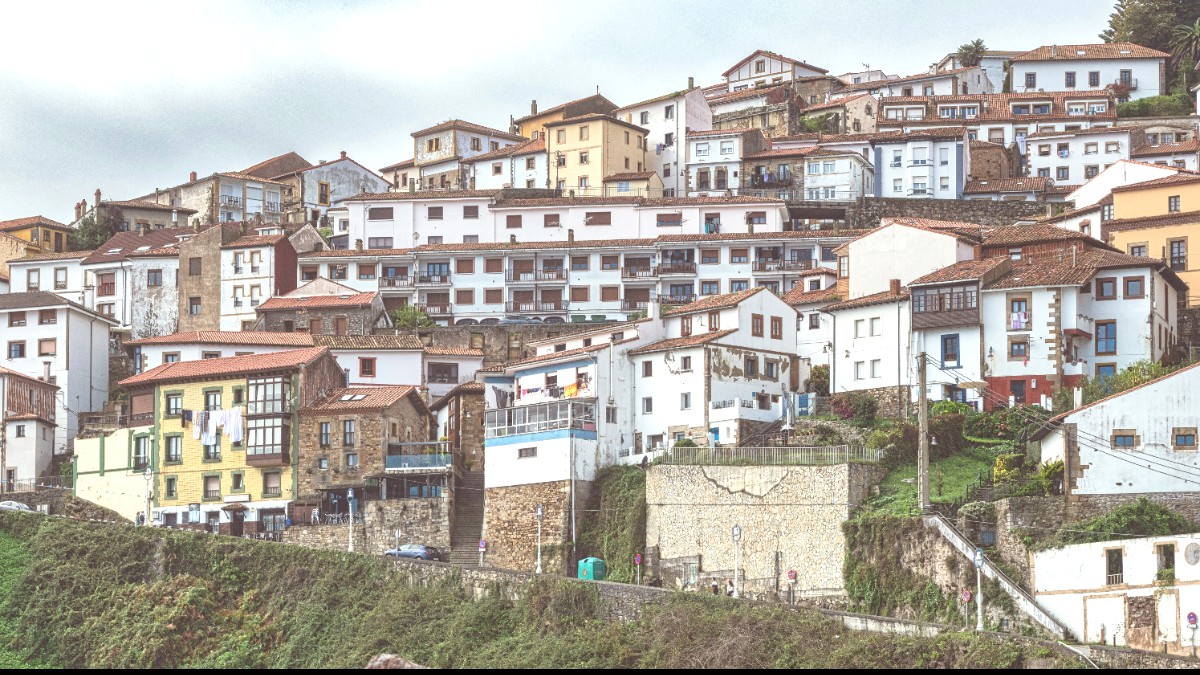
Asturias, Spain
Asturian cuisine stands out for its quality ingredients, traditional cooking methods, and distinct flavors. Its identity comes from the region's agricultural bounty and access to the Cantabrian Sea.
Key ingredients include Fabes (beans), cured meats like Chorizo and Morcilla, high-quality Ternera Asturiana beef, and fresh seafood. Asturias produces over 40 types of cheeses, including Cabrales, Gamoneu, and Afuega'l Pitu. Flavors are often savory, earthy, and rich.
Lunch (Comida) is the main meal of the day, typically served from 2:00 PM to 4:00 PM. Dinner (Cena) is late, usually from 9:00 PM to 11:00 PM. Many restaurants close between these services.
It is common to order several plates of Tapas (small snacks) or Raciones (larger sharing plates) to share among the table. This lets you taste a wider variety of dishes.
In Sidrerías, natural cider is traditionally poured from a height (Escanciado) to aerate it, releasing its flavors and creating a slight fizz. An Escanciador (cider pourer) often does this for you. Do not attempt this yourself without knowing the technique.
A rich, hearty bean stew. Features large white Asturian beans (Fabes), cured pork shoulder (Lacón), Chorizo, Morcilla (Asturian blood sausage), and often Panceta (pork belly). A highly recommended dish to try.
Find in virtually all traditional Asturian restaurants and Sidrerías.
Two large, thin veal fillets (other meats sometimes used) stuffed with cured ham and cheese (often Cabrales or another Asturian cheese), breaded, and fried. Usually served with french fries and roasted peppers.
Highly popular in Sidrerías and traditional eateries across the city.
Creamy rice pudding, a classic dessert. Often comes served with a caramelized sugar crust (Quemado) on top, creating a delightful texture and flavor contrast.
Widely available in most traditional restaurants and Sidrerías.
In autumn and winter, find street vendors selling warm, roasted chestnuts. A comforting seasonal snack.
Small portions of Empanadas (savory pies) or other savory pastries are in local bakeries (Panaderías).
Oviedo offers a wide range of dining experiences, from casual to upscale.
Known for traditional Asturian cuisine presented with a refined, modern touch.
Offers contemporary interpretations of Asturian classics, overseen by acclaimed chef Nacho Manzano.
Popular for its fresh seafood and traditional Asturian dishes.
Serves classic Asturian fare in a welcoming environment.
Excellent for budget-friendly dining. Order Raciones with cider. This makes an affordable full meal.
Perfect for affordable breakfast or afternoon snack (coffee and pastry).
Central municipal market with some stalls selling prepared foods, for a casual and affordable lunch.
Small portions of Empanadas (savory pies) or other savory pastries are in local bakeries.
Oviedo's main municipal market. A great spot for local life and ingredients.
A beautifully renovated market building, mainly for events. Check local listings.
Growing selection of Italian, various Asian, and South American options.
Find alternatives if you desire non-local cuisine.
Popular restaurants fill quickly, especially for dinner or on weekends. Booking a table is advisable for a smooth dining experience.
Tipping is customary but not mandatory. A small amount for good service. If service is included, leaving extra is optional.
Embrace late meal times and shared dishes. The city features a lively food scene, especially in its traditional cider houses.
Participating in cider pouring at a Sidrería is a unique local tradition. It is a social and sensory experience integral to Asturian culture.
Asturias is proud of its dairy and native produce, visible in the markets. Fresh, regional ingredients form the basis of local cuisine.
Awareness of gluten-free (Sin gluten) options increases in Spain, especially in larger cities and modern establishments.
Communicate your needs clearly. You can say, "Soy celíaco/a" (I am celiac).
For other allergens, use a translation app or a pre-prepared allergy card in Spanish to explain your restrictions.
While some restaurants offer gluten-free dishes, cross-contamination risks can exist in kitchens.
Apps like "HappyCow" can help locate vegan or vegetarian-friendly establishments in Oviedo. Look for online forums or blogs specializing in gluten-free or vegan travel in Spain.
Be prepared for some limitations, especially in traditional eateries. Oviedo's larger restaurants and modern cafes generally have more adaptable menus.
Some private chefs or culinary schools in Oviedo offer classes focusing on Asturian cuisine.
Guided walking food tours are available, often focusing on the Old Town and Calle Gascona.
Opportunities exist in the wider Asturian region to visit food producers.
The "Bulevar de la Sidra" is a unique dining concept. The experience of shared Raciones and cider, often with friendly banter, is a quintessential Oviedo experience.
A social and sensory immersion into local culture.
Experiencing or observing this traditional pouring method is an integral part of Asturian dining. It is a skill and a performance, aerating the cider and contributing to its unique taste.
Embrace this custom to truly participate in the local food scene.
Various local festivals celebrate cider throughout Asturias, often during summer months. Check local calendars for specific dates and locations.
Oviedo frequently hosts themed gastronomic weeks, focusing on specific products like mushrooms or local vegetables. These events provide opportunities to sample special menus and dishes.
During the San Mateo Fiestas (mid-September), expect more street food stalls, outdoor dining, and special menus offered by restaurants.
Before your visit, consult local listings and tourist information offices for current food festivals or gastronomic events.
Embrace late meal times and the social aspect of sharing dishes. Do not pour cider yourself unless you understand the technique.